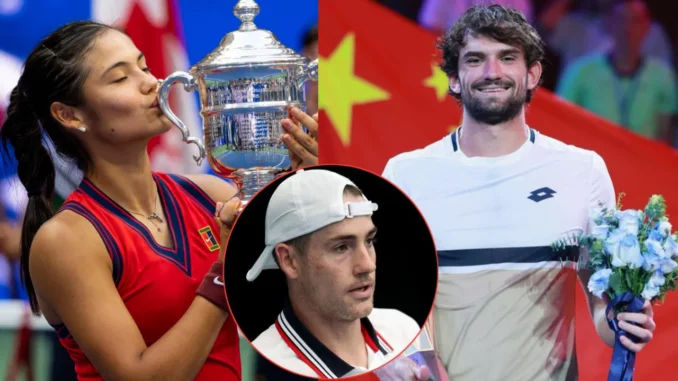
In the world of professional tennis, where rankings and experience often dictate outcomes, every now and then an underdog emerges to rewrite the script in spectacular fashion. Such was the case at the 2025 Shanghai Masters, where Valentin Vacherot, a relatively unknown player from Monaco, stunned the sport by claiming the title as a qualifier. This remarkable feat has sparked intense discussions, particularly after retired American star John Isner weighed in, declaring Vacherot’s journey even more impressive than Emma Raducanu’s historic US Open victory in 2021.
Vacherot’s path to glory began under unlikely circumstances. Ranked a modest No. 204 at the start of the tournament, he wasn’t even high enough on the list to enter the qualifying draw directly. It took a string of withdrawals from higher-ranked players for the 26-year-old to sneak in as an alternate—the ninth one, no less. Seizing the opportunity, Vacherot powered through his two qualifying matches to earn a spot in the main draw, marking his first appearance at a Masters event outside of his home tournament in Monte Carlo.
But Vacherot didn’t stop at merely qualifying. He embarked on a dream run, defeating a gauntlet of established names: Laslo Djere in the first round, followed by Alexander Bublik, Tomas Machac, Tallon Griekspoor, and Holger Rune. The highlight came in the semifinals, where he toppled none other than Novak Djokovic, a 24-time Grand Slam champion and one of the greatest players in history. In the final, Vacherot faced his cousin, Arthur Rinderknech, in a family affair that added a layer of personal drama to the triumph. Emerging victorious, Vacherot became only the third man in tennis history to win a Masters 1000 title as a qualifier. Overnight, his ranking skyrocketed to No. 40, thrusting him into the upper echelons of the ATP Tour and promising a transformed career ahead.
This Cinderella story inevitably drew parallels to another qualifier’s miracle: Emma Raducanu’s unforgettable run at the 2021 US Open. At just 18 years old and ranked No. 150, the British teenager burst onto the scene in her second-ever Grand Slam appearance. Fresh from completing her school exams, Raducanu won three qualifying matches without dropping a set, then stormed through the main draw, defeating top seeds like Belinda Bencic and Maria Sakkari en route to the title. In total, she claimed 10 straight victories—all in straight sets—culminating in a final win over Leylah Fernandez. Raducanu’s achievement made her the first qualifier, male or female, to ever win a Grand Slam, etching her name in the annals of tennis history and sparking a global media frenzy.
It was against this backdrop that John Isner, the former world No. 8 known for his towering serve and marathon matches, shared his thoughts on the Nothing Major podcast alongside fellow ex-pros Sam Querrey, Steve Johnson, and Jack Sock. When asked if Vacherot’s Shanghai success outshone Raducanu’s US Open feat, Isner didn’t hesitate. “I think it is more impressive, yes,” he stated. “But Raducanu, it’s a bigger story because it’s the US Open. I think this is more improbable than what she did. But her winning the US Open makes it a bigger story, even though this story is really big in the tennis world. I am giving it to Vacherot there. It’s just unheard of.”
Isner’s comments ignited a firestorm among tennis enthusiasts, with many rushing to defend Raducanu’s legacy. Critics pointed out the inherent differences between a Masters 1000 event and a Grand Slam, noting that the latter’s best-of-five-set format (for men) and deeper field make it exponentially tougher. One fan argued that recency bias was at play, emphasizing that while a qualifier winning a Masters isn’t entirely unprecedented, clinching a Slam as one remains unparalleled. Others highlighted Raducanu’s youth and inexperience—she was a true rookie, having not even secured a WTA Tour win before her US Open breakthrough—contrasting it with Vacherot’s more seasoned 26 years on the circuit.
The debate underscores the magic of underdog narratives in tennis, a sport where mental fortitude and momentum can defy odds. Raducanu’s victory came at a time when she was balancing adolescence with sudden stardom, leading to immense pressure that has since seen her grapple with injuries, coaching changes, and inconsistent form. Despite flashes of brilliance, like strong showings in later tournaments, she has yet to replicate that major success, which only amplifies the improbability of her 2021 run. Vacherot, on the other hand, is at the dawn of what could be a breakout phase. Hailing from Monaco, he turned pro later than most, honing his skills on the Challenger circuit before this breakthrough. His win over Djokovic, in particular, showcased a blend of powerful groundstrokes and unflappable composure that could propel him toward top-20 contention.
Yet, beyond the comparisons, both stories highlight tennis’s capacity for inspiration. Vacherot’s triumph reminds us that perseverance pays off, even for those starting from the fringes. Raducanu’s tale, meanwhile, speaks to the raw potential of youth and the thrill of the unknown. As Isner himself acknowledged, the scale of the stage matters— a Grand Slam carries a mythic weight that a Masters, prestigious as it is, can’t fully match. Still, Vacherot’s nine-match winning streak in Shanghai, against a field depleted by absences but still featuring giants like Djokovic, stands as a testament to grit.
In the end, pitting these achievements against each other might miss the point. Tennis thrives on such moments, where qualifiers become champions and spark conversations that keep the sport alive. Whether you side with Isner’s bold take or the chorus of Raducanu supporters, one thing is clear: these improbable journeys enrich the game, proving that in tennis, fairy tales can indeed come true. As the tour moves forward, eyes will be on Vacherot to see if he can sustain this momentum, while Raducanu continues her quest to reclaim her place among the elite. The beauty lies in the uncertainty—and the endless debates it fuels.
Leave a Reply